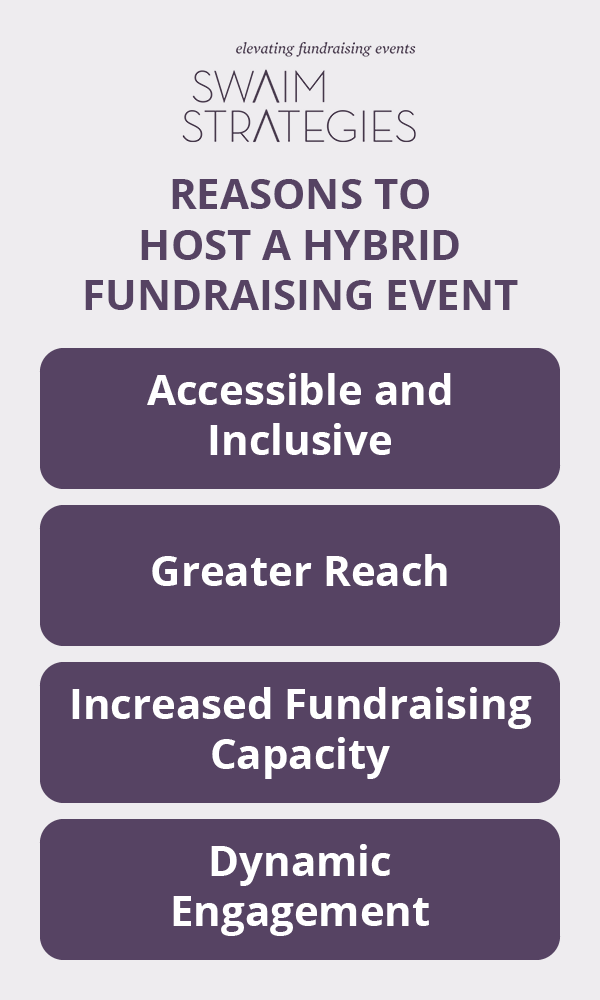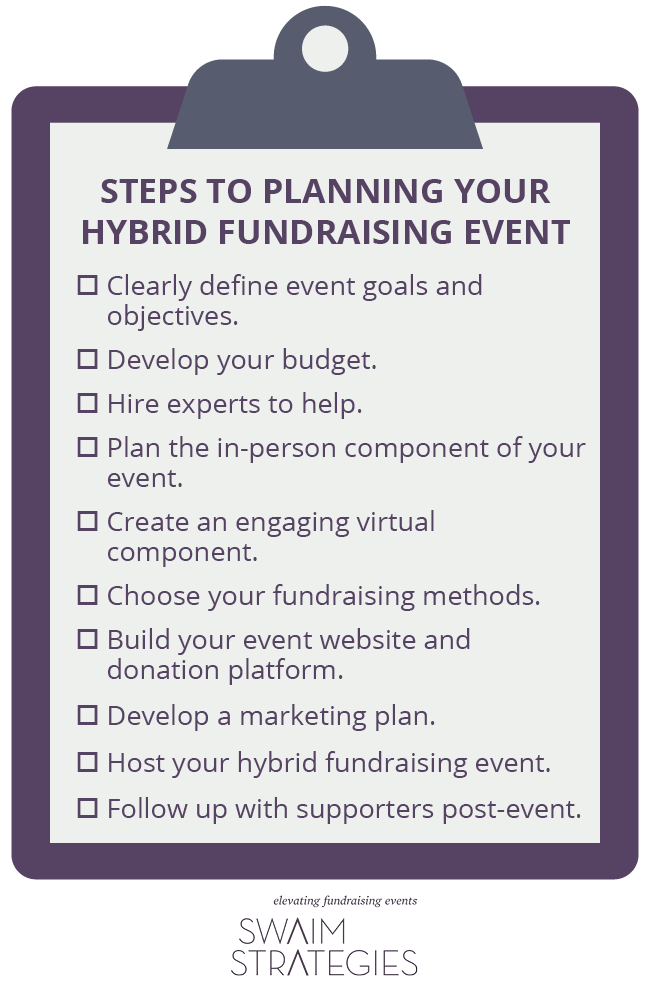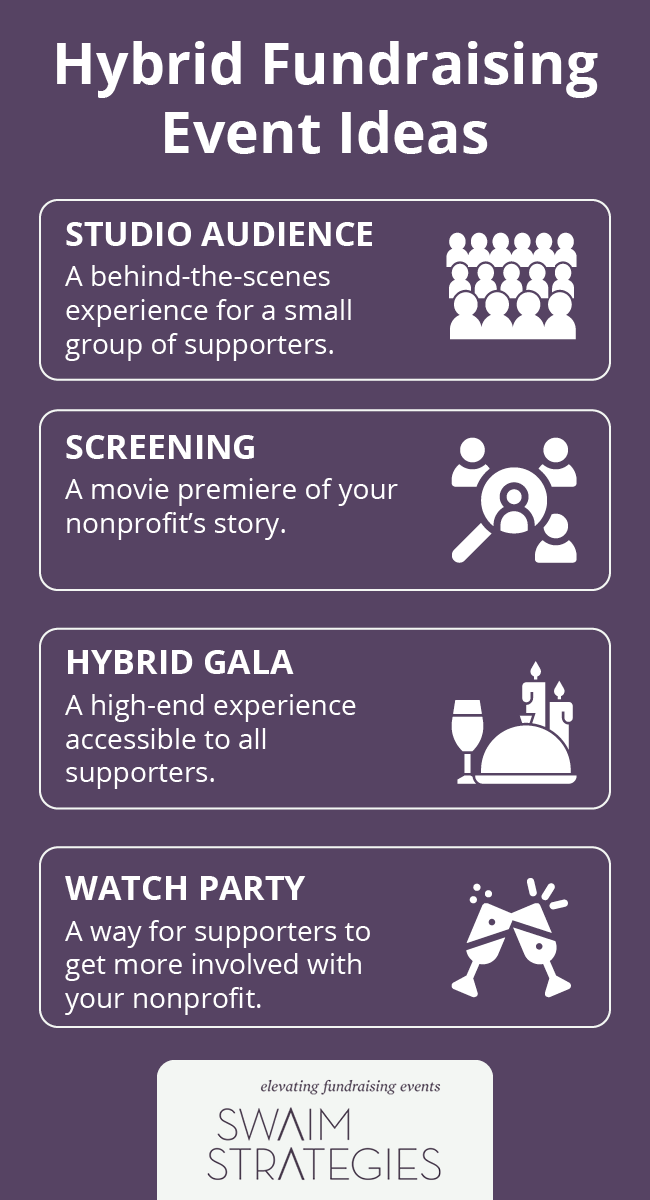Melding In-Person and Virtual with Hybrid Fundraising Events
Fundraising events help nonprofits drive impact and generate the revenue necessary to further their cause. Over time, nonprofits have begun augmenting their event experiences with technology to create a more engaging experience for attendees. In particular, hybrid fundraising events have become increasingly popular—they allow nonprofits to leverage the benefits of in-person events, such as connection and community, while including the benefits of virtual events, such as access and greater outreach. Ultimately, hybrid events include more people and raise more money.
In this guide, we’ll cover the basics of hybrid fundraising events, including:
- What is a Hybrid Fundraising Event?
- Why Host a Hybrid Fundraising Event?
- 10 Steps to Planning a Hybrid Fundraising Event
- 4 Hybrid Fundraising Event Ideas
When planned thoroughly and organized properly, hybrid fundraising events are memorable experiences that resonate with all attendees. Let’s begin by explaining what a hybrid fundraising event is!
What is a Hybrid Fundraising Event?
A hybrid fundraising event is a nonprofit event that combines both in-person and virtual elements. For example, a live stream of a gala is a hybrid event—the gala is the in-person element and the live stream is the virtual element. By broadcasting your in-person program online, you offer attendees the opportunity to engage and donate to your mission from anywhere in the world with an internet connection.
Hybrid events allow you to:
- Build awareness of your mission across a broad audience
- Acquire new donors
- Celebrate and thank the staff and volunteers who move your mission forward
- Share stories of your mission in a compelling way
- Move people to action
- Build community
For a quick overview of what hybrid fundraising events look like, take a look at the Swaim Strategies hybrid event demo and sizzle reel. These videos will give you an idea of what a hybrid event can look and feel like.
Why Host a Hybrid Fundraising Event?

In a 2022 study, more than half of fundraising event donors said they prefer having virtual engagement options at events. This makes hybrid fundraising events a great choice for nonprofits, as these events have unique benefits you can leverage to create the desired impact. These include:
1. Accessibility and Inclusiveness
Historically, fundraising events were designed for major donors, and over time, they’ve evolved to involve donors of all types. Now, you can leverage technology to serve your entire donor base. While engaging major donors will always be an important part of your strategy, hybrid events offer another way to encourage as many people as possible to gather on your organization’s behalf.
Hybrid events are the most accessible format because they enable your guests to join the event in the way that’s most convenient for them, whether that’s in-person or online. Gathering is at the root of any powerful movement, including racial justice movements, environmental movements, and social justice movements. By gathering in a hybrid format, your whole community can come together to make a movement possible in support of your mission.
2. Greater Reach
Because hybrid fundraising events are partially virtual, your nonprofit can reap one of the main benefits of virtual events, which is that you can reach a larger audience. Not only can you invite more attendees than your venue can hold, but you can also attract a diverse audience that includes attendees who may not be able to attend in person, but can participate remotely.
For nonprofits who work in multiple locations or have missions regarding statewide or even worldwide impact, hybrid fundraising events are open to all donors, no matter where they are. Imagine being able to unite your donors in Portland, Oregon, and Lusaka, Zambia at the same time for a live program. For one focused moment, you have the attention of your entire audience—and you’re a nonprofit they love and want to support.
3. Increased Fundraising Capacity
A hybrid fundraising event provides a unique and memorable experience for attendees. The in-person portion of the event can create a sense of community and connection, while the virtual aspect allows for broader reach and can incorporate interactive elements such as live streaming, virtual tours, and online auctions. This can increase the potential for donations and help to raise more money for the organization.
4. Dynamic Engagement
Hybrid events allow you to dream beyond a ballroom gala with a sit-down dinner. They can be transformational experiences. For example, your nonprofit can rent an auditorium for a theater-style program that engages viewers in a new and fresh way. With a hybrid event format, you won’t need to worry about running out of seats, as you can live stream the event to remote attendees. By dynamically engaging with your supporters, attendees will have a more memorable experience and form stronger connections with your nonprofit.
10 Steps to Planning a Hybrid Fundraising Event

To make the most of your hybrid fundraising event, you’ll want to plan your event thoroughly. This can take months, as there are many components to keep in mind. Here are the 10 steps to planning a successful hybrid fundraising event.
1. Clearly define the goals and objectives of your event.
The first step to planning out your event is clearly defining the objective of your event. Ask yourself the following questions:
- What is your fundraising goal?
- Who is your target audience?
- What is your key message or theme?
After asking these questions, choose a hybrid event format that best suits your goals. For example, if one of your goals is to give existing supporters another way to engage more deeply with your nonprofit, you could organize a hybrid gala event, where supporters can interact with your board members, staff, and dedicated volunteers.
2. Develop your budget.
Working out a budget for your hybrid event includes both revenue and expenses. Additionally, you’ll want to identify target prospects for every level of giving to ensure you have a path to reach your goals. In particular, conduct prospecting for the following major revenue sources:
- Major donors: Before your event, cultivate major donors and ask them to commit to a specific amount that will be announced as a gift at the event. These pre-committed gifts build momentum during your event and set the tone for guests to give. The goal is to secure large gifts beforehand and create incentives, such as matching gifts, for giving at lower levels.
- Sponsorship: Offer exclusive sponsor levels and benefits for your hybrid fundraising event to encourage higher-level giving. Focus on building relationships, asking what benefits and collaboration potential sponsors are interested in, fulfilling those benefits, and showing gratitude. Sponsors will respond favorably to the visibility they’ll receive during your event.
- Matching opportunities: When cultivating your major donors or sponsors, remember to consider opportunities for matching gifts. For this form of fundraising, your major donors and sponsors can pre-commit to matching donations of a certain amount—for example, a major donor may choose to pre-commit $50,000 towards matching gifts of $500 or more. This offers another opportunity to recognize your major donors and sponsors while you leverage their gifts to inspire giving at lower levels.
Major revenue sources such as these will get you closer to your fundraising goal. By planning ahead, doing research, and prospecting ahead of time, you’ll help secure the success of your hybrid fundraising event.
3. Hire experts to help.
For nonprofits that may not have staff members with event planning experience, hiring an expert can help streamline the event process. This is especially true for hybrid events, which must address both an in-person and online audience. At Swaim Strategies, we offer these specific services:
- Event planning
- Strategic consulting
- Storytelling consulting
- Event data, software, and registration consulting
A consultant will provide your nonprofit with specific recommendations that you can use to organize a successful hybrid fundraising event that helps you build relationships with your community. Or, if you don’t have the budget for a consultant, there are many free online resources that can help guide you through the process. For instance, Swaim Strategies offers training webinars and hosts a fundraising podcast to help you with your hybrid fundraising event.
4. Make a comprehensive plan for the in-person component of your event.
Because a hybrid fundraising event uniquely combines in-person and virtual aspects, you’ll want to make a comprehensive plan for each aspect. For the in-person component, your plan should include a compelling event concept, an in-person guest list, and a venue that can accommodate both.
To spice up your event, hire vendors such as:
- Caterers
- DJ or musicians
- Entertainers
- Graphic designers
- Photographers
- Videographers
These vendors will create a more entertaining experience for your guests, resulting in stronger connections between them and your nonprofit.
5. Create an engaging virtual component for your hybrid fundraising event.
There are many ways to make the online component of your hybrid event feel compelling and special. We recommend integrating some of the following elements into your event to ensure your online audiences have a great experience:
- Use a virtual event platform that provides a seamless user experience, such as OneCause.
- Recognize online donors by name live during the program.
- Live stream your event on Vimeo or YouTube.
- Pre-record videos to make your event more dynamic.
- Incorporate text-to-give with software like Give Lively.
- Implement an online chat so virtual guests can interact with one another and your team.
We highly suggest having a roaming camera in your physical event space to give virtual attendees an engaging way to experience the event. This camera will move around and capture what’s happening in the space, helping virtual attendees feel included in the in-person event.
6. Choose your fundraising methods.
Use a variety of fundraising methods to engage your in-person guests, virtual attendees, and others who’d like to invest in your mission. Here are a few methods your nonprofit can implement at your next hybrid fundraising event:
- Direct appeals: With a direct appeal, your nonprofit can directly solicit support from event attendees by telling a story of transformation that shows your mission in action.
- Online auction: Run an online auction with a platform such as Greater Giving to allow attendees to bid on packages in support of your nonprofit. While the return on investment for online auctions is generally lower than live auctions, it gives your online viewers and even people who can’t attend your event a way to support you.
- Live auction: A live auction offers an incentive for people to attend your in-person event to bid on exclusive packages. It can also be incorporated in your run of show to strategically build momentum in the room and encourage bigger giving during your direct appeal.
- Raffle: A raffle is a low-risk and inexpensive opportunity for both in-person and virtual attendees to win a prize. Check raffle laws in your state to ensure that your raffles are compliant.
- Peer-to-peer fundraising challenges: During peer-to-peer fundraising, your nonprofit’s passionate supporters will collect donations from their networks in support of your organization. This makes it possible to gain support from people who might not otherwise be familiar with your organization. Peer-to-peer fundraising challenges are best conducted in advance of your hybrid event.
Diversify the fundraising methods you implement to encourage a variety of supporters to give at your hybrid fundraising events. For example, supporters that may not be willing to bid in an auction may be willing to purchase a raffle ticket.
7. Build your event website and donation platform.
A dedicated event website and donation platform will make it easy for supporters and potential attendees to access all your hybrid fundraising event details in one place. These details include:
- When and where your event is taking place
- The purpose of your event
- How to tune in
- What to expect for both in-person and virtual audiences
- Ways for people to donate, regardless of if they plan to attend your event
Make attending and donating as simple as possible to encourage a higher amount of attendees and gifts. Having an event website will also make your event seem more professional, lending your nonprofit more credibility.
8. Develop a marketing plan.
Marketing is an incredibly important part of any event. You’ll have the greatest success by starting your marketing campaign several months or weeks before your event. Starting early also enables you to collect and use the data and analytics from your marketing assets, like your newsletter and social media posts, to know whether you’re on the right track or need to shift gears.
Look for opportunities to make both in-person and virtual audiences feel invited. Aside from sending messages through your usual communication channels, feel free to get creative. This might mean sending personalized video invitations to potential attendees, or exploring how to boost virtual attendance, including creating calendar invites for folks to add to easily add to their calendars.
Plus, if your event is a success and you want to host another hybrid or virtual event in the future, you can use this marketing plan as a template for future promotional efforts.
9. Host your hybrid fundraising event.
During the event, ensure that you have everything set so attendees will have a smooth in-person registration experience. Have a group of volunteers ready to help you greet guests, run registration, and sell raffle tickets. On the virtual side, make sure that tech support is on standby to address any issues that crop up.
Even after spending months planning an event, unforeseen circumstances can still occur. Have backup plans in place in case proceedings do not go as planned. This could mean having team members on deck in case a key person in your hybrid fundraising event is unable to attend, or having a tent available for in-person attendees in case it rains unexpectedly.
10. Follow up with supporters post-event.
Sharing gratitude with the people who donated time and money to your nonprofit during an event is one of the simplest ways to continue building a strong relationship with your donors and community. After your event has ended, thank attendees and donors for their support. Pay special attention to major donors and sponsors, as their support is crucial to the success of your event.
Additionally, post your event footage or a video recap on Youtube or another video-sharing platform, and add the video to your event website. Share the experience with people unable to attend by sending an on-demand viewing link to your email list and posting the link on social media.
4 Hybrid Fundraising Event Ideas

A hybrid fundraising event can be whatever you want it to be. Whether you want to host a “television show” with a studio audience, a movie premiere in the park, or a traditional ballroom gala, you can do it and make it hybrid. Here are four hybrid event ideas you can use for your next event:
1. Studio Audience Experience
A studio audience experience is a hybrid fundraising event for a small group of people gathered in person for a live broadcast of your program, offering an intimate behind-the-scenes experience. By inviting key donors to participate in your program in person, you can give them a special experience without the costs of producing a giant in-person gala event. Furthermore, your online broadcast of the event will give other supporters a way to participate and feel appreciated.
Use your A/V team to create an experience for your online viewers that includes your studio audience. For example, your A/V team can capture video and audio footage of the room. This allows remote participants to see and hear what’s going on, making them feel as if they’re in the room. This makes your online broadcast a dynamic experience.
2. Screening
Screenings emulate a night out to the movies, complete with a big screen and theater-style seating, to focus the attention of your audience on the same program that your at-home guests are enjoying. Think of it as a movie premiere telling your nonprofit’s story, with socializing time before and after the show.
These hybrid fundraising events are cost-effective, easily scalable in terms of the number of attendees, and can be casual or formal. They are an accessible way to gather your supporters, and they work well in an auditorium or a flexible space with multiple seating options. You can also take the opportunity to be creative, such as by hosting an outdoor, summertime gathering with a broadcast at sunset. Or you could bring back the drive-in movie experience like the drive-in gala Clackamas Women’s Services hosted.
3. Hybrid Gala
Going hybrid doesn’t mean you have to leave behind the traditional gala. If your community looks forward to your black tie benefit each year, share the live program with a virtual audience.
Hybrid galas are a great way to continue giving your guests a high-end experience while making your program accessible to any supporters who might want to participate. This makes everyone feel included as part of your mission.
4. Watch Party
A watch party is hosted by a supporter, such as a board member or a donor, to gather their network of friends together to watch your online broadcast. Depending on the size of the gathering, hosts can either invite guests to their homes or another smaller venue. Your nonprofit can support hosts by providing them with tools for success, like this watch party toolkit.
Watch parties are a great option for nonprofits who want to include a wide range of donors that live in more than one place. For example, if your headquarters is in Portland, Oregon, but you have chapters in Salem, Bend, and Corvallis, you can invite everyone to be a part of the same event. These hybrid fundraising events also provide a unique opportunity for volunteers and donors who want to be more involved with your nonprofit to try their hand at hosting an event on your nonprofit’s behalf. Furthermore, you’ll be able to tap into your hosts’ networks to recruit new supporters.
Conclusion and Additional Resources
By now you have the tools you need to plan a successful hybrid event fundraiser. But we know it can still be challenging to do it on your own, especially when you’re wearing several hats. At Swaim Strategies, we’ve spent decades planning fundraising events, helping nonprofits across the world raise money for their missions. If you need support while planning your next fundraiser, we’d love to help. Reach out to us or book some consulting time and let us know what you need. Or, if you want to expand your knowledge about all things fundraising, we host an annual conference for fundraising events.
If you’re interested in learning more about hybrid fundraising events, take a look at the following resources:
- Planning the Perfect Nonprofit Event: A Comprehensive Guide – Deepen your understanding of nonprofit event planning by reading this complete guide.
- Do These 5 Things to Plan a Successful Hybrid Event – Get our top tips for making sure your hybrid fundraising event goes off without a hitch.
- 9 Must-Read Fundraising Books for Nonprofit Professionals – Want to learn more about nonprofit fundraising? Start with these nine books.








